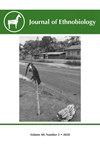通过研究阿根廷干旱地区野生动物的突出性“编织”不同的知识体系
IF 1.3
3区 社会学
Q1 ANTHROPOLOGY
引用次数: 2
摘要
摘要当前的生物多样性保护框架探索“自然-人”的关系,承认文化的核心作用。本研究旨在将当地知识与科学生态数据结合起来,更好地了解野生动物与当地人之间的关系。我们在一个村庄(Los Baldecitos)工作,该村庄位于Ischigualasto省立公园(阿根廷圣胡安)的影响区域。我们进行了20次免费上市面试和12次半结构化和开放式面试。我们分析了不同物种的总体显著性(通过自由列表和认知显著性指数建立)如何通过生态(通过物种占用模型测量)和文化(通过访谈表达)方面的显著性来解释。认知显著性指数与动物占用率呈正相关,但无统计学意义(Spearman’s Rho = 0.48, P = 0.095, N = 17)。这可能意味着文化方面(动物用途、与态度和自然保护有关的看法)与解释总体显著性有关。其中10种的显著性最高,统计上最显著,并被相机陷阱记录。它们中的一些与人类共享空间(村庄、供水点、畜栏和家畜区),而另一些则不太可能与人类共享栖息地。由于物质(有形利益、生态功能)和非物质(情感、情感、审美、口头表达)价值,野生物种具有与使用和接受相关的文化价值。两种食肉动物因其对家畜的掠食性伤害而引起负面反应。本研究展示了如何将当地知识和科学知识结合起来,以理解人与自然的关系。本文章由计算机程序翻译,如有差异,请以英文原文为准。
“Weaving” Different Knowledge Systems through Studying Salience of Wild Animals in a Dryland Area of Argentina
Abstract. The current biodiversity conservation framework explores “nature-people” relationships, recognizing culture's central role. This study aimed to combine local knowledge with scientific ecological data to better understand the relationships between wild animals and local people. We worked in a village (Los Baldecitos) located in the area of influence of Ischigualasto Provincial Park (San Juan, Argentina). We conducted 20 free listing interviews and 12 semi-structured and open ones. We analyzed how the overall salience of different species (established through free listing and cognitive salience index) can be explained by ecological (measured through species occupancy models) and cultural (expressed in interviews) aspects of salience. The cognitive salience index and estimated animal occupancy showed a positive correlation, although it was not statistically significant (Spearman's Rho = 0.48, P = 0.095, N = 17). This could mean that cultural aspects (faunal uses, perception related to attitudes and to nature conservation) were relevant in explaining overall salience. Ten species had the highest and most statistically significant salience and were recorded by camera traps. Some of them share spaces with people (village, water points, corrals, and domestic animal areas), and others were less likely to share habitats where people are present. Wild species have cultural value related to uses and acceptance due to material (tangible benefits, ecological functions) and non-material (affectionate, emotional, aesthetic, presence in oral expression) values. Two carnivores elicited negative reactions because of their predatory damage to domestic animals. This study demonstrates methods to interweave local and scientific knowledge to understand people-nature relationships in context.
求助全文
通过发布文献求助,成功后即可免费获取论文全文。
去求助
来源期刊

Journal of Ethnobiology
Social Sciences-Anthropology
CiteScore
4.80
自引率
3.40%
发文量
21
审稿时长
>12 weeks
期刊介绍:
JoE’s readership is as wide and diverse as ethnobiology itself, with readers spanning from both the natural and social sciences. Not surprisingly, a glance at the papers published in the Journal reveals the depth and breadth of topics, extending from studies in archaeology and the origins of agriculture, to folk classification systems, to food composition, plants, birds, mammals, fungi and everything in between.
Research areas published in JoE include but are not limited to neo- and paleo-ethnobiology, zooarchaeology, ethnobotany, ethnozoology, ethnopharmacology, ethnoecology, linguistic ethnobiology, human paleoecology, and many other related fields of study within anthropology and biology, such as taxonomy, conservation biology, ethnography, political ecology, and cognitive and cultural anthropology.
JoE does not limit itself to a single perspective, approach or discipline, but seeks to represent the full spectrum and wide diversity of the field of ethnobiology, including cognitive, symbolic, linguistic, ecological, and economic aspects of human interactions with our living world. Articles that significantly advance ethnobiological theory and/or methodology are particularly welcome, as well as studies bridging across disciplines and knowledge systems. JoE does not publish uncontextualized data such as species lists; appropriate submissions must elaborate on the ethnobiological context of findings.
 求助内容:
求助内容: 应助结果提醒方式:
应助结果提醒方式:


